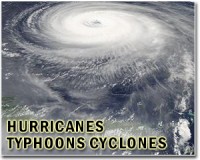| . |  |
. |
Baguio, Philippines (AFP) Oct 19, 2010 Super Typhoon Megi smashed into the northern Philippines on Monday, causing landslides in mountainous areas, whipping up huge waves along the coast and killing at least one person. Forecasters said Megi was probably the most powerful storm in the world this year and the strongest to hit the Philippines since Typhoon Durian unleashed mudslides that buried entire towns and killed more than 1,000 people in 2006. With the storm forecast to sweep into the South China Sea, Chinese authorities on Tuesday issued a disaster warning across southern coastal areas. Megi pummelled remote coastal areas of the northern Philippines with gusts of up to 260 kilometres (160 miles) an hour on Monday morning as it made landfall, tearing roofs off houses and bringing down power lines. "We are marooned inside our home. We cannot go out. The winds and rain are very strong. Many trees are being uprooted or snapped in half," Ernesto Macadangdang, a resident of Burgos town in Isabela province, told DZBB radio. Megi's force slowed after making landfall with maximum wind gusts of 215 kilometres an hour, but it continued to dump rain across the northern half of the main island of Luzon throughout the afternoon. The northeastern provinces of Isabela and Cagayan were the first to feel the typhoon's fury on Monday morning. "There are landslides in the mountains, we have swells, storm surges and big waves along the coastline, and now we have flood alerts," chief weatherman Graciano Yumol said in an interview with GMA 7 television. Isabela and other provinces in Megi's direct path are mostly agricultural and fishing areas, with a few million residents who are well-drilled in preparing for the many storms that hit each year. More than 3,000 people had already been moved from their homes in the northern provinces as part of a "pre-emptive evacuation" of threatened areas, the civil defence office said. Local television showed footage of debris, including fallen trees and electrical posts, littering the highway leading to Isabela's provincial capital Ilagan just hours after Megi hit land. Flights to and from northern Luzon were also suspended and ships there were told not to leave port. Military, police and relief agencies had positioned supplies and rescue units to provide swift assistance to any affected areas, the civil defence office reported. The government said the US military had also offered six heavy lift helicopters to help if needed. Authorities reported one death by late Monday afternoon, but with many areas remained cut off from communications, officials fear the death toll could rise. Cagayan province governor Alvaro Antonio said rising waters had made many bridges impassable, adding that strong winds made it dangerous to venture out. "You cannot travel. It is very dangerous even if you use a vehicle. The wind is very strong and the rains are getting stronger," he said. "We cannot as of yet give you a complete picture or assessment of the extent of the damage." The sole reported fatality was of a man who drowned in a river while fishing, the nation's civil defence chief, Benito Ramos, told reporters. The state weather bureau said Megi was expected to exit the Philippines' western coast for the South China Sea later Monday, but said storm alert signals remained hoisted over much of Luzon island. Megi did not directly hit the nation's capital, Manila, although its 12 million residents were told to remain on alert for possible heavy rains. The Chinese provinces of Guangdong, Guangxi, Hainan and Fujian were on alert for powerful winds, heavy rains, floods and landslides over coming days, state media reported. In Hainan, an island province which has already been battered by torrential rains since the start of October, the relief effort has been allocated 40 yuan (six million dollars) life jackets, rafts and equiptment to counter flooding. More than 1,100 people were killed when Tropical Storm Ketsana and Typhoon Parma struck Manila and other parts of Luzon within a week of each other last year, triggering the worst flooding in recent history. The Philippines is battered by an average of 20 typhoons a year, but Megi looked set to make records as one of the fiercest in recent memory. Rosalinda de Guzman, head of the government's climatology data division, told AFP that Megi was the strongest typhoon to hit the Philippines since Durian in 2006. Forecasting website Accuweather reported Megi was the strongest cyclone anywhere in the world this year, but de Guzman said local authorities were not able to make a global comparison. strs-mm-jvg/kma/slb/boc
Share This Article With Planet Earth
Related Links Bringing Order To A World Of Disasters When the Earth Quakes A world of storm and tempest
 One dead as Typhoon Megi whips northern Philippines
One dead as Typhoon Megi whips northern PhilippinesBaguio, Philippines (AFP) Oct 18, 2010 Super Typhoon Megi smashed into the northern Philippines on Monday, causing landslides in mountainous areas, whipping up huge waves along the coast and killing at least one person. Forecasters said Megi was the strongest storm to hit the Philippines since Typhoon Durian unleashed mudslides that buried entire towns and killed over 1,000 in 2006, and was likely the most powerful in the world t ... read more |
|
| The content herein, unless otherwise known to be public domain, are Copyright 1995-2010 - SpaceDaily. AFP and UPI Wire Stories are copyright Agence France-Presse and United Press International. ESA Portal Reports are copyright European Space Agency. All NASA sourced material is public domain. Additional copyrights may apply in whole or part to other bona fide parties. Advertising does not imply endorsement,agreement or approval of any opinions, statements or information provided by SpaceDaily on any Web page published or hosted by SpaceDaily. Privacy Statement |